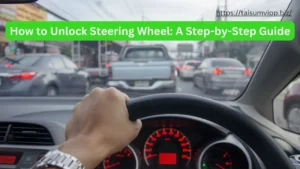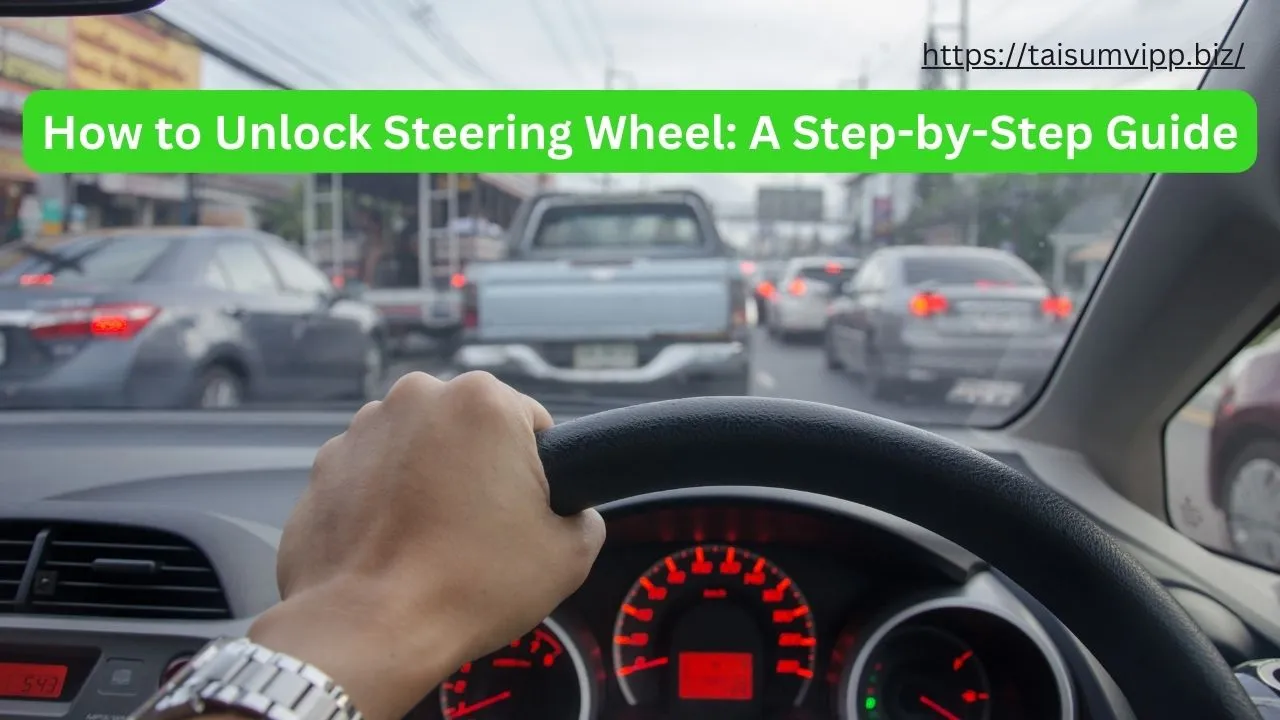Experiencing a locked steering wheel can be both frustrating and alarming. Understanding the mechanisms behind it and learning how to address the issue is crucial for any car owner. This guide will take you through the essentials of unlocking your steering wheel step-by-step, ensuring you can get back on the road safely.
Understanding the Steering Wheel Lock Mechanism
The steering wheel lock mechanism is designed to protect your vehicle from theft and unauthorized use. It engages automatically when you remove the key from the ignition, locking the steering column and preventing movement. Knowing how this system works will help you understand why it may become stuck and how to resolve the issue.
The Purpose of a Steering Wheel Lock
The primary purpose of the steering wheel lock is to deter thieves by immobilizing the vehicle’s steering system. When a thief attempts to turn the wheel without the key, the lock mechanism engages, making it much harder to drive the vehicle away. This added layer of security offers peace of mind for vehicle owners. Additionally, many modern vehicles incorporate advanced anti-theft technologies alongside the steering wheel lock, such as alarms and immobilizers, creating a multi-faceted approach to vehicle security. These enhancements work in tandem to increase the difficulty for potential thieves, often leading them to abandon their attempts altogether.
How a Steering Wheel Lock Works
The steering wheel lock functions through a series of pins and tumblers that engage when the ignition key is removed. The mechanism connects to the ignition system, preventing the wheel from moving unless the correct key is inserted and turned. This connection is vital, as it ensures that only the keyholder can unlock the steering wheel and drive the car. Furthermore, the design of the steering wheel lock has evolved over the years, with manufacturers continually improving the robustness of these systems. For instance, some newer models utilize electronic steering column locks that can be controlled by the vehicle’s onboard computer, adding another layer of complexity that makes it even more challenging for thieves to bypass the system. Understanding these advancements can help vehicle owners appreciate the importance of regular maintenance and updates to their car’s security features.
Common Reasons for a Locked Steering Wheel
Locked steering wheels typically result from specific issues, often related to the ignition system or the steering column itself. Identifying the root cause can help in effectively unlocking the steering wheel.
Ignition Switch Issues
One common reason why a steering wheel may become locked is due to problems with the ignition switch. If the ignition switch is malfunctioning, it might not properly communicate with the steering lock mechanism. This can happen if the switch is worn out, corroded, or damaged. In such cases, turning the key may not release the lock. Additionally, if the vehicle’s battery is weak or dead, it can also lead to ignition switch issues, as insufficient power may prevent the switch from functioning correctly. Regular maintenance of the ignition system, including checking battery health and connections, can help prevent these frustrating situations.
Steering Column Problems
Another reason for a locked steering wheel is mechanical problems within the steering column itself. Over time, components can wear out or become misaligned, leading to jam and immobilization. Issues such as broken pins or damage to the locking mechanism can also contribute to this problem, making it essential to inspect the steering column if you encounter persistent locking issues. Furthermore, if the vehicle has been involved in an accident, even a minor one, the steering column may have sustained hidden damage that could lead to locking issues later on. It’s advisable to have a professional mechanic examine the steering system after any collision to ensure all components are functioning as intended.
Key-Related Issues
In addition to ignition switch and steering column problems, key-related issues can also lead to a locked steering wheel. If the key is bent, worn, or not the correct key for the vehicle, it might not engage the ignition switch properly. This can prevent the steering lock from being released, leaving the driver unable to steer the vehicle. In some cases, using a spare key can resolve the issue, but if the problem persists, it may indicate a deeper issue with the ignition system that requires further investigation. Ensuring that keys are kept in good condition and regularly checking for wear can help mitigate these types of problems.

Precautions Before Unlocking Your Steering Wheel
Before attempting to unlock your steering wheel, it’s vital to take specific precautions. These measures ensure your safety and the well-being of your vehicle during the unlocking process.
Safety Measures to Consider
Always prioritize safety when dealing with vehicle issues. Before you start, ensure the car is parked in a safe location away from traffic. Avoid any attempts to forcibly turn the key or the steering wheel, as this can cause additional damage. It’s also wise to have someone nearby who can assist in case of unexpected complications. Furthermore, consider turning on your hazard lights to alert other drivers that your vehicle is stationary and may require assistance. This small step can help prevent accidents and ensure your safety while you work on the steering wheel.
Necessary Tools for Unlocking
Equip yourself with the right tools before you begin unlocking your steering wheel. You may need:
- A flathead screwdriver
- A wrench or socket set
- A lubricant, such as WD-40
Having these tools at hand can make the unlocking process much smoother. Always ensure that the tools you use are suitable for your vehicle’s make and model to avoid any complications. Additionally, consider having a flashlight handy, especially if you’re working in low-light conditions or at night. This will help you see clearly what you’re doing and avoid any potential mistakes. If you’re unsure about the process, it might also be beneficial to consult your vehicle’s owner manual for specific instructions related to your model, as different cars can have unique locking mechanisms that require tailored approaches.
Step-by-Step Guide to Unlocking Your Steering Wheel
Now that you’re prepared, follow this step-by-step guide to unlock your steering wheel effectively. Each step is critical for ensuring you do not damage any components during the process.
Initial Steps for Unlocking
Start by gently moving the steering wheel from side to side while inserting the key into the ignition. This action can sometimes release tension on the lock mechanism, allowing the steering wheel to unlock. If this doesn’t work, use the flathead screwdriver to carefully pry open any debris around the ignition area if you notice dirt or grime.
Next, try turning the key while continuing to move the steering wheel. Make sure to apply gentle pressure rather than force, as excessive force can damage the lock or ignition switch. It’s important to remember that steering wheel locks are designed as a security feature, which means they can be particularly stubborn at times. If you find yourself struggling, take a moment to breathe and reassess your approach to avoid frustration.
Troubleshooting Persistent Locks
If the steering wheel remains locked, it may be necessary to inspect the ignition switch and steering column more closely. Remove any necessary panels to access the steering column and check for visible signs of wear or damage. If you find a malfunctioning ignition switch, consider replacing it to resolve the issue. Additionally, ensure that the battery is fully charged, as a weak battery can sometimes prevent the ignition system from functioning correctly, leading to a locked steering wheel.
If you do not feel comfortable performing these repairs, it may be best to contact a professional mechanic. They can quickly diagnose and fix the underlying issues to ensure your vehicle operates safely. Remember that while DIY repairs can be rewarding, safety should always come first. A qualified technician has the expertise and tools to handle complex problems that may not be immediately apparent, such as electrical issues or deeper mechanical failures that could be contributing to the lock. Taking this step can save you time and potential future headaches.

Tips to Prevent Future Steering Wheel Locks
After successfully unlocking your steering wheel, it’s essential to implement strategies to prevent future occurrences. Taking proactive steps can save you a lot of time and frustration down the road.
Proper Parking Techniques
One effective way to prevent your steering wheel from locking is to ensure you park your vehicle correctly. Always turn the steering wheel while the ignition is still on, making sure to allow the locking mechanism to engage properly. This ensures that the mechanism is engaged rather than mistakenly jammed when you leave the vehicle. Additionally, consider the incline of the surface where you park. Parking on a slope can sometimes exacerbate the locking mechanism, so it’s wise to choose a flat area whenever possible. This simple adjustment can help maintain the integrity of the steering lock system.
Regular Maintenance and Check-ups
Additionally, schedule regular maintenance for your vehicle, focusing on the ignition system and steering components. Regular check-ups will help detect any potential issues before they become serious problems. Make it a habit to inspect the steering column and ignition switch, especially if you notice any unusual behavior with the steering wheel or ignition system. It’s also beneficial to keep an eye on the condition of your key fob or traditional key, as wear and tear can impact the ignition system’s performance. A worn key might not engage the ignition properly, leading to unexpected steering wheel locks.
By understanding the steering wheel lock mechanism, knowing how to troubleshoot issues, and following proper maintenance, you can minimize the risk of facing a locked steering wheel in the future. Furthermore, consider investing in a steering wheel lock bypass device, which can provide an extra layer of protection and convenience. Such devices are designed to prevent the steering lock from engaging under certain conditions, allowing for smoother operation of your vehicle without compromising security. This proactive approach not only enhances your driving experience but also instills confidence in your vehicle’s reliability.
